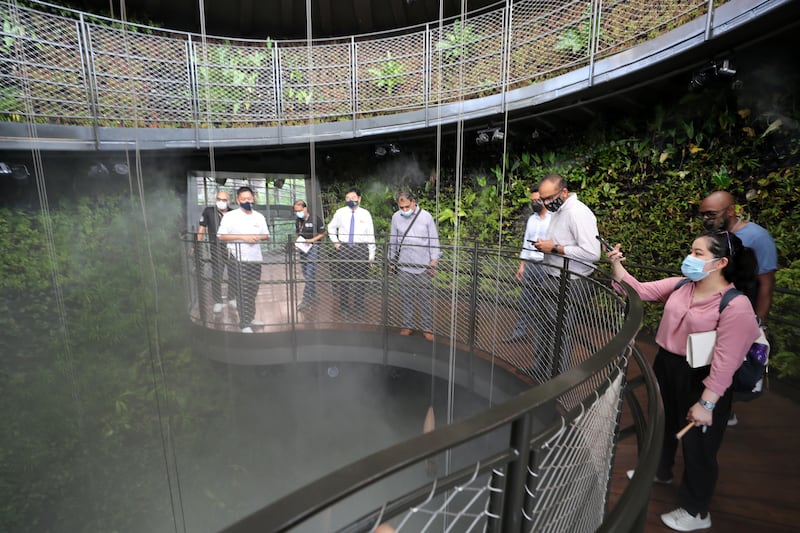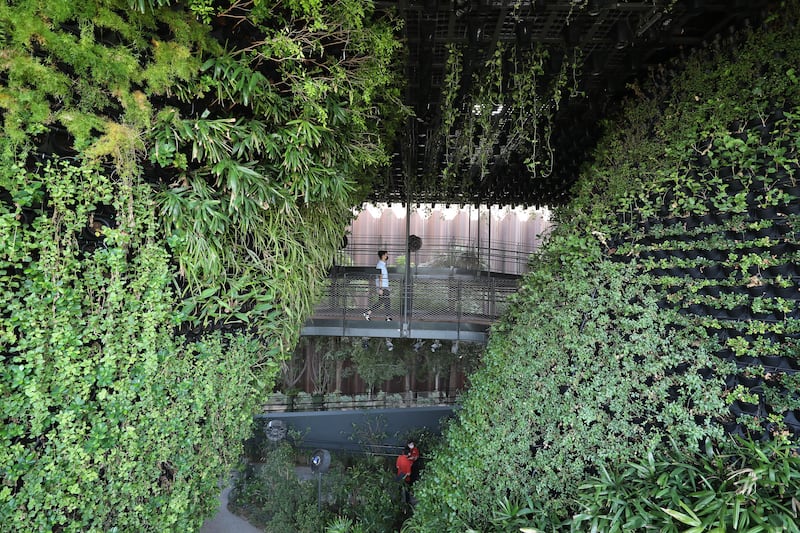The winding walkways of Singapore’s pavilion at Expo 2020 Dubai are shaded with lush greenery.
The point its designers want to make is that nature can thrive in the middle of the desert - if helped to do so sustainably.
Two days before the Expo opening ceremony, organisers opened the pavilion on Tuesday for a preview to show how the landscaped spaces reflect the city-state’s vision of creating a “city in nature".
Towering cones within are covered with more than 80,000 plants. Rows of trees and desert palms shade the interior as fans shoot cool mist on to visitors who walk in.
More than 500 solar panels on the roof will provide electricity for the pavilion all through the six-month Expo that opens on Friday.
Larry Ng, commissioner general of the Singapore Pavilion, described it as the “greenest in the whole of Expo”.
“First the beautiful greenery helps to lower the temperature inside and the 517 photovoltaic panels up in the roof will provide energy for the pavilion,” he told The National.
“Energy from the solar panels will also be used to desalinate the water that we pump from underground so this expounds the concept of sustainability and renewable energy.”
Drip irrigation has been used to minimise water wastage.
More than 170 varieties of plants have been regrown, many endemic to the desert and several brought in from Singapore.
Sun-loving plants such as Singapore’s national flower, the pink Vanda Miss Joaquim, will greet people at the entrance.
Plants found in freshwater streams and mangroves line the interior.

The structure built on 1,550 square metres is among the smallest on the Expo site and aims to show how space-starved Singapore has adopted environmentally-friendly actions to address climate change.
It is also among the few pavilions with no air conditioning where natural ventilation and architecture is used to control the air flow.
Organisers said designing a shaded structure that allowed fresh outdoor air to constantly circulate would keep visitors at ease, particularly during the Covid-19 pandemic.
“As we are using photovoltaic energy, we have tried to reduce the usage of energy,” Mr Ng said
“It is fully ventilated. We are using trees and dry mist to lower the temperature internally by 6 to 10 degrees. When you come in, you will feel the difference.
“Especially during this time of the pandemic, you are advised to be in the open because in many ways you are safer. So we are trying to address issues of sustainability and the pandemic.”
Smart technology is integrated into the pavilion.
Round machines called ‘climbing robots’ move across the structure to check the health of plants and transmit data if, for instance, sections require more water.
Visitors can download a mobile game that makes them feel they are a part of a collective effort to keep the greenery alive. Game users need to complete tasks to work out how much sunlight and water the plants require.
This hands-on approach has won over many volunteers.
Farihin Ismail was among several volunteers waving the Singapore flag at the entrance of the Expo gates.

The 26-year-old Singaporean moved with her parents to Abu Dhabi about 10 years ago.
She travels daily on an Expo Rider bus from Abu Dhabi to the site and is thrilled to be part of her home country’s offering at the World Fair.
“I’m learning a lot about Singapore’s lively living in nature experience,” she said.
“I love living in Dubai and Abu Dhabi and helping out for my country Singapore even while I’m overseas.”
Light shows every night and film screenings will present stories about the people of Singapore.
Documentaries and short films will focus on global challenges from climate change to food security.
Walking tours through the pavilion will take place four times daily with guides giving visitors a behind-the-scenes look at the working of the structure.
“We hope that they will gain new perspectives on how nature and technology can be integrated into our urban spaces, and see the possibilities of how our cities can be designed to be sustainable, liveable and resilient,” Mr Ng said.
For updates on the Singapore pavilions programmes, check: www.singapore2020expo.gov.sg.























